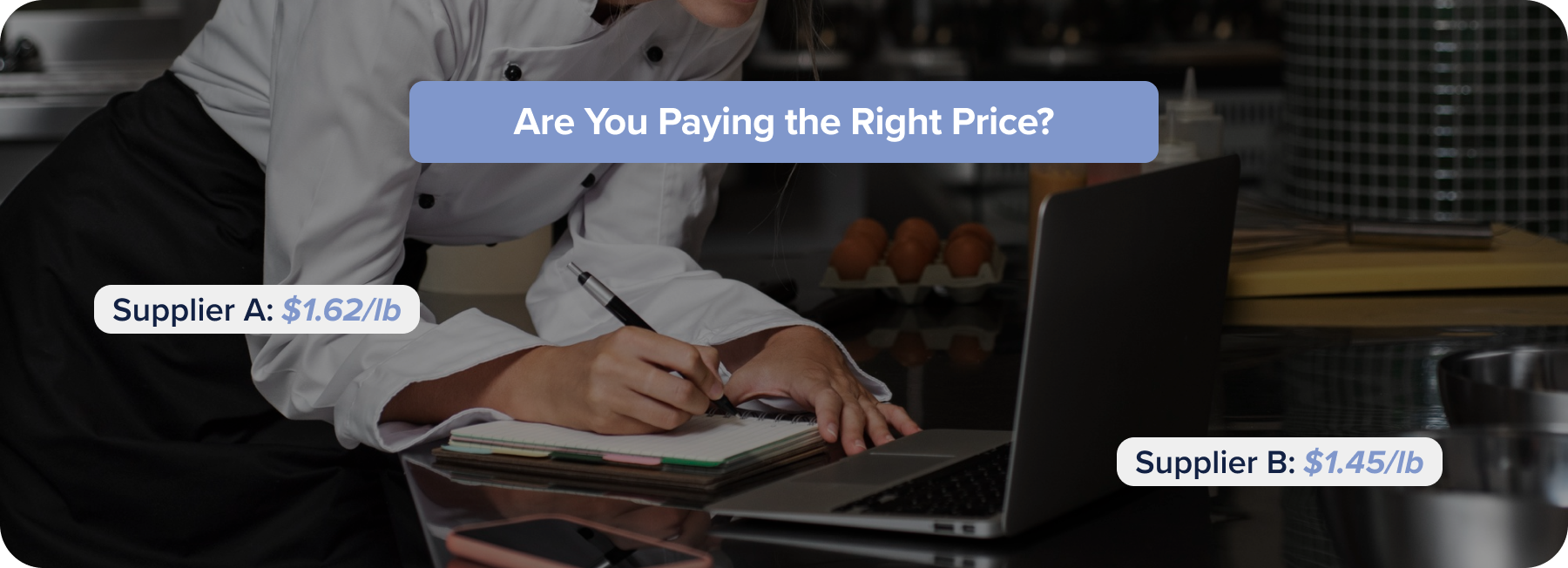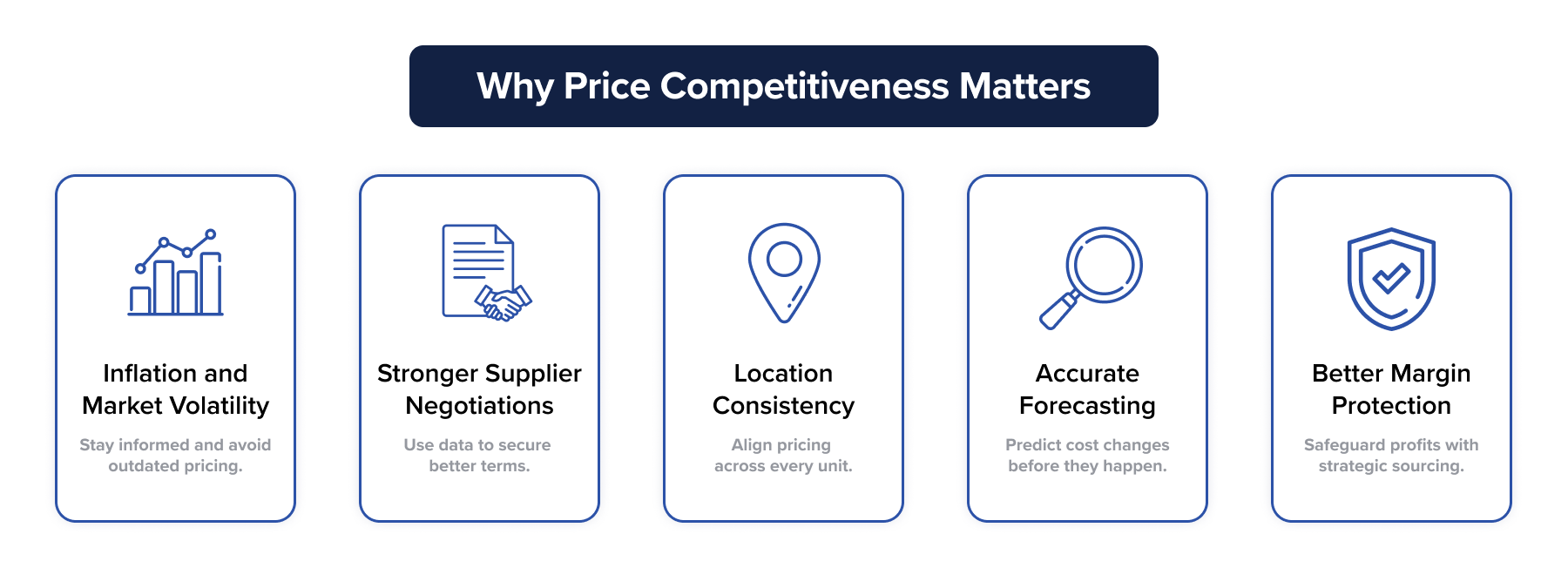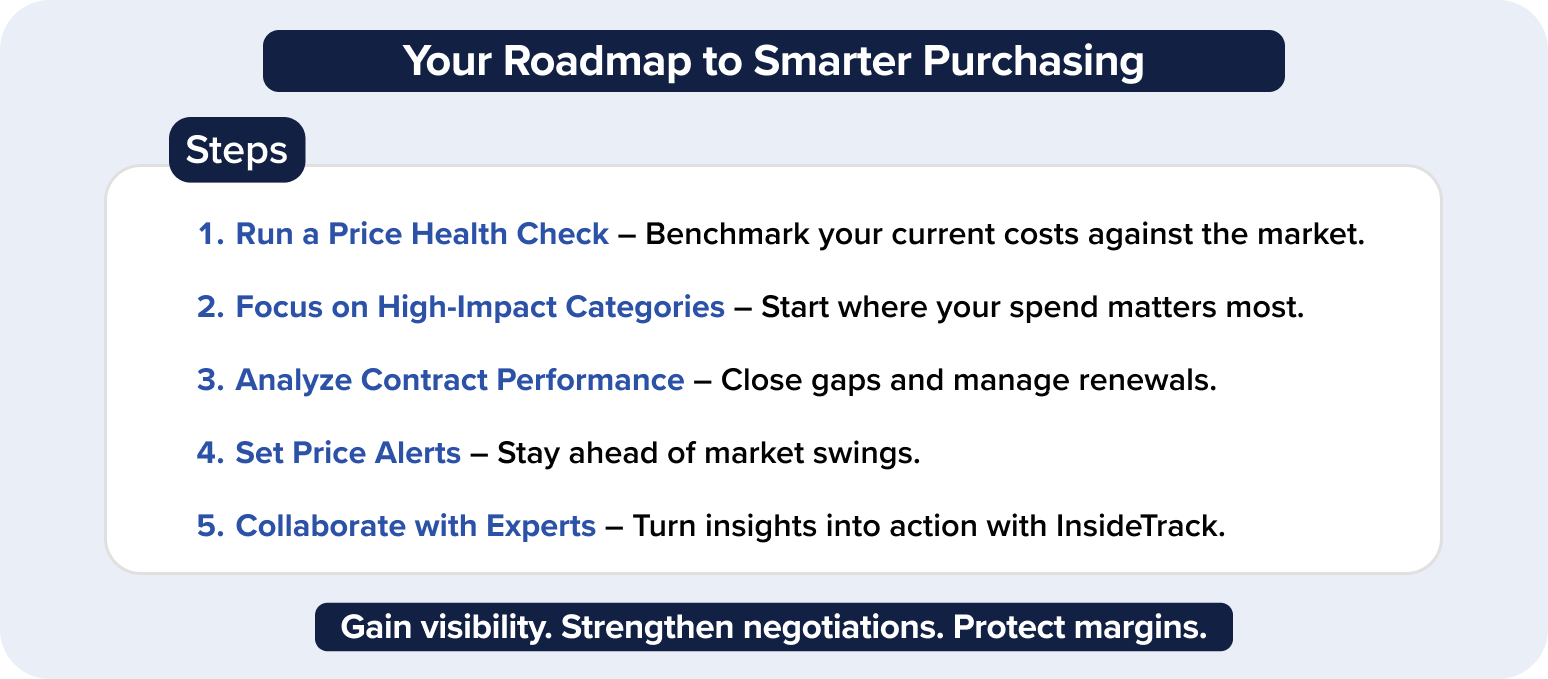You’ve got two suppliers quoting different prices for the same product. One’s a few cents cheaper, but is it really the better deal? Without procurement benchmarking, you can’t tell if you’re getting a fair price or quietly spending too much every week if you don’t know how your prices compare to the rest of the market.
That’s where price competitiveness and procurement benchmarking comes in. It’s the difference between making educated, strategic purchasing decisions and taking guesses that chip away at your margins.

What is Price Competitiveness?
In the simplest terms, price competitiveness is your ability to maintain pricing that aligns with the broader market while still protecting your profit margins. It’s not about chasing the lowest cost. It’s about knowing the right cost based on real data.
In foodservice, operators often assume they’re getting the best possible deal because they trust their suppliers or rely on past experience. But with prices shifting constantly across proteins, produce, and pantry staples, it’s easy to fall behind.
For example, let’s say you’re paying $1.62 per pound for boneless, skinless chicken breasts. Market data might reveal that most operators are paying closer to $1.45. That small gap, multiplied over hundreds of pounds per week, quickly becomes a costly blind spot.
InsideTrack helps close that gap by showing you how your pricing stacks up against more than $44 billion in purchasing data across 2,700+ USDA markets.
Price competitiveness is about seeing the full picture. It ensures that you’re not just buying smart, but buying strategically.
Why Price Competitiveness Matters in Foodservice
Running a profitable restaurant or hospitality operation is all about control. You control the menu, the labor, and the guest experience. But if you don’t have control over your pricing data, you’re leaving one of your biggest cost centers up to chance.
Here’s why price competitiveness and procurement benchmarking are essential for long-term success:
- Inflation and Market Volatility – Inflation and market swings make it hard to predict the prices of ingredients. You could be stuck in old contracts that don’t reflect the current state of the market if you don’t have real-time data.
- Stronger Supplier Negotiations – Your data is what makes your negotiations strong. When you know your prices are higher than the average for your industry, you can ask for better terms.
- Location Consistency – Multi-unit operators need to keep prices the same across all of their restaurants or concepts in order to keep profits steady. Benchmarking makes that possible.
- Accurate Forecasting – Market insights help you see cost changes coming before they happen, so you can plan ahead, change menu prices, or re-evaluate relationships with suppliers.
- Better Margin Protection – Every penny counts. If you set competitive prices, you won’t lose money on items that could be bought more strategically.

Being price competitive isn’t just about paying less. It’s about being smart with your money.
How InsideTrack Helps You Stay Price Competitive
InsideTrack gives operators the information they need to set prices. You can change the way your business buys things by using market intelligence, benchmarking, and contract forecasting together.
Here’s how each feature supports price competitiveness.
1. Benchmark Prices with Confidence
You can’t make things better if you can’t measure them. InsideTrack’s Price Health Check allows you to compare your item-level pricing against more than $44 billion in verified industry spend data.
This benchmarking tool helps you find items that are too expensive, shows you where you might be able to save money, and gives you data you can use in negotiations with suppliers.
With Price Health Check, you can:
- Compare your pricing to actual market averages.
- Spot high-cost outliers and correct them quickly.
- Use data-backed insights to strengthen supplier conversations.
Benchmarking helps you stop making guesses when you buy things and move from reactive buying to proactive strategy.
2. Evaluate, Forecast, and Optimize Contracts
Contracts are the backbone of any purchasing strategy, but they’re often forgotten once signed. That’s where opportunity is lost.
InsideTrack’s Procurement Center helps you track and evaluate every contract you manage. By comparing contracted items against unmanaged spend, you’ll know exactly where gaps exist.
Even better, you can forecast how renewals or term changes will affect your future costs using two-year price projections and historical data.
This method helps you:
- Make sure contracts stay in line with changes in the market.
- Find unmanaged spending and get it under control.
- Get ready for renewals long before the due date.
The result? Smarter contracts, lower costs, and fewer pricing surprises.
3. Mitigate Market Risk Before It Impacts Your Costs
In foodservice, timing is everything. Prices change quickly, and not being ready can cost you thousands.
InsideTrack gives you access to 2,700+ USDA markets, complete with weekly trend updates. You can also set up custom alerts for important commodities so that you know right away when prices start to change.
This visibility helps you:
- Stay informed of commodity shifts before they affect your invoices.
- Adjust purchasing strategies in real time.
- Build a more resilient pricing model.
When you can see what’s coming, you can act before the market does.
Real World Benefits of Price Competitiveness
Understanding your price competitiveness doesn’t just improve your procurement strategy. It transforms how you operate.
When operators regularly compare and keep an eye on prices, they get the following:
- Higher Margins: Getting rid of SKUs that cost too much adds up quickly. A small 2–3% drop in costs can make a big difference in how much money you make.
- Stronger Decision Making: You can back up every purchase choice with real, verifiable data. You don’t have to rely on what suppliers say or what you think anymore.
- Improved Supplier Partnerships: Being open and honest builds trust. It makes for more balanced, long-term relationships when both sides know the numbers.
- Resilient Operations: With price forecasts and alerts, you’re ready for market fluctuations rather than reacting to them after the fact.
- Strategic Agility: Having the data means you can pivot faster, whether that means adjusting your menu mix or sourcing from alternative suppliers.
How to Get Started with Procurement Benchmarking

Improving your price competitiveness doesn’t require an overhaul. It starts with visibility.
Here’s a quick roadmap to begin:
Run a Price Health Check
Benchmark your top items to see how your current pricing compares.
Focus on High-Impact Categories
Review the items that make up most of your spend, such as proteins, dairy, and produce.
Analyze Contract Performance
Identify unmanaged spend and review your renewal timelines.
Set Price Alerts
Stay updated on the market movements that matter most to your business.
Collaborate with Experts
Work alongside InsideTrack’s procurement and data experts to turn insights into action.
When you take these steps, price competitiveness becomes part of your strategy, not an afterthought.
Turning Insight into Action
Price competitiveness and procurement benchmarking help operators make better buying decisions by giving them the information they need. It’s not about taking shortcuts. It’s about knowing everything about your buying landscape and using what you learn to make your business stronger.
You can confidently compare prices, predict contracts, and keep an eye on market trends with InsideTrack. When you know the market, you’re not just reacting to it; you’re leading it.
Fill out the form below or click here to explore Price Competitiveness with InsideTrack.


